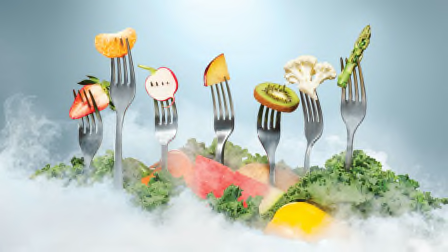Answers to Common Questions About Coronavirus and the Food You Eat
Food safety experts address 12 top concerns

In addition to worrying about having an ample supply of food in the house and feeling anxious over shopping in crowded supermarkets, people are also concerned about whether they can get COVID-19—the disease caused by the new coronavirus—from the groceries and takeout they’re buying.
Here’s the good news: “The science around coronavirus continues to unfold, but there is currently no evidence that the disease is transmitted by food,” says Donald Schaffner, Ph.D., a distinguished professor in the department of food science at Rutgers University in New Brunswick, N.J.
That’s because it’s a respiratory virus, passed primarily from person to person in droplets when someone who is infected coughs or sneezes. Though it’s possible to pick up the virus by touching a surface where the droplets have landed and then touching your eyes, nose, or mouth, that’s not the primary way it is thought to spread, according to the Centers for Disease Control and Prevention.
The CDC, the Food and Drug Administration, the Department of Agriculture, and the World Health Organization say that food is not known to be a route of transmission of the virus. And the information available from outbreaks of SARS and MERS, caused by coronaviruses similar to the one that causes COVID-19, is reassuring. According to the WHO, the evidence showed that those illnesses were not transmitted by food.
Q. Do meats and other animal products carry the virus?
Because the first cases were linked to a live animal market in China, it may have led some people to think so. But there’s no evidence of this.
According to a paper in the International Journal of Hygiene and Environmental Health, “the main symptoms in patients have been fever and respiratory related symptoms, therefore the mode of transmission needs to be respiratory, quite unlikely oral via food.”
How did those people become infected, then? Research is continuing, but it’s believed that the virus originated in bats, then spread to another animal, then to people. “Whenever there is close association between people and live animals, there’s the potential for a virus to make a species jump,” Schaffner says. “As far as we know, animals in this country are not affected,” Schaffner says. Plus the primary route of transmission is person to person.
Q. Are foods eaten raw, like fruits and vegetables, safe?
It’s theoretically possible that if someone who’s infected sneezes directly on an apple, you pick up that apple and then touch your face, you could get infected. “But you’re much more likely to get infected standing next to that person at the apple bin,” Schaffner says. That’s why social distancing requires putting at least 6 feet of space between you and other people. And why you should wash or sanitize your hands as soon as possible after touching things at the grocery store. “Those are the biggest things you can do to mitigate your risk,” Schaffner says. And if you are concerned, you can eat cooked produce instead of raw.
Q. Should you wash produce any differently from your normal method?
That’s not necessary. Just wash fruits and vegetables in water, using a vegetable brush if you like on hard produce, such as apples or potatoes. “I don’t recommend washing produce with soap or diluted bleach solution, both of which can cause stomach upset,” Schaffner says. Vinegar won’t kill the virus, and there’s no evidence that vegetable washes do, either.
Q. Can you pick up the virus from food packaging?
According to the CDC, the coronavirus is primarily transmitted person to person through respiratory droplets. “We haven’t seen food or food packaging as a source of transmission,” Chapman says. That said, if you touch something that has the virus on it and then touch your nose, mouth, or eyes, you could become infected.
In the case of food packaging, however, the risk is low. In a preliminary study published in The New England Journal of Medicine on March 17, researchers tested the stability of the new coronavirus on a variety of surfaces. They found that the virus remained on plastic and stainless steel for up to 72 hours. On cardboard, they found no viable virus after 24 hours.
But the virus begins to degrade quickly. The half-life—or the time it takes for the concentration of virus to drop by 50 percent—was 5.6 hours on stainless steel and 6.8 hours on plastic. The half-life on cardboard was a little more than 3 hours, although the researchers said there was a wider variation among the samples they tested than for stainless steel or plastic.
“Just because the virus is there, doesn’t mean that there are enough viable particles there to infect you,” CR’s Rogers says. And the chances that any particular package was exposed to all the factors that would be necessary for it to have the virus on it in the first place are also low.
You can further reduce the risk by taking the following steps: Wash your hands when you get home from the grocery store. Place your groceries on a surface you can clean. Unpack your groceries, clean the surface, and wash your hands again. If you are particularly worried, you can wipe down glass jars, cans, plastic tubs, etc., with a disinfecting wipe or transfer the contents to a new container.
Q. A worker at a store where you bought food tested positive. Should you toss out the food?
The experts say this isn’t necessary. The FDA says it doesn’t expect that foods would need to be recalled or withdrawn from the market because of COVID-1 concerns. You may hear of stores shutting down for a few days after an employee tests positive. According to the FDA, this depends on state requirements, but the decisions will be based on the risk of person-to-person transmission, not food safety.
Q. Should you avoid takeout or delivery from restaurants?
“No,” Chapman says. “I actually see it as a very good alternative since, unlike grocery shopping, it greatly reduces the need to interact with other people.” Most restaurants have instituted contactless delivery or pickup practices that allow people to prepay for their food and receive it without coming close to another human. “The biggest risk factor for the disease is interacting closely with other people, and contactless delivery eliminates that,” Chapman says. To further reduce your risk, transfer your food to a plate when you get it, dispose of the containers, then wash your hands before you eat.
Q. Could a sick restaurant employee contaminate your food?
In general, restaurants have food safety standards they’re required to follow, mostly to avoid transmission of five foodborne bacteria and viruses—salmonella, E. coli, shigella, norovirus, and the virus that causes hepatitis A. Those standards would prevent the new coronavirus from getting into your food, too. In addition, the FDA recommends that during this time food facilities should “redouble cleaning and sanitation efforts to control any risks that might be associated with workers who are ill regardless of the type of virus or bacteria.”
Q. Should you wash reusable grocery bags?
It may feel safer to switch to single-use disposable bags during this outbreak, but experts say that’s not necessary. “I do launder my reusable cloth bags after every trip to the grocery store,” Chapman says. “We don’t have any evidence that they’re transmitting illness, but it’s a smart practice.” Washing grocery bags will keep foodborne bacteria from multiplying. When you get home from the store, put away your food, toss the bags in a hot water wash, then wash your hands.
Q. Are the FDA and USDA still working to prevent, detect, and track foodborne illness?
These government agencies are responsible for the safety of the nation’s food supply, including monitoring imported products, inspecting food processing facilities, and setting safety protocols for food facilities. USDA inspections at meat and poultry slaughterhouses to check for bacteria such as E. coli and salmonella are continuing. To protect its inspectors, the FDA, which oversees most other foods, has scaled back on its routine inspections, which are done every few years based on a risk analysis. But the agency says that inspections it considers mission-critical will continue and that it will still respond to foodborne outbreaks.
“We’re thinking ahead, though, and encouraging the USDA to remain vigilant about oversight of sanitation practices in meat and poultry plants, and be transparent about the number of inspectors that test positive or become ill with COVID-19,” says Brian Ronholm, CR’s director of food policy. Ronholm sent a letter to Mindy Brashears, the USDA’s undersecretary for food safety, on March 31 outlining CR’s concerns.
“We aren’t worried about the meat becoming contaminated with the new coronavirus,” he says, “but we want to continually monitor the overall safety of the meat and poultry supply.”
USDA doesn’t oversee worker safety, only food safety, but Ronholm says we are in a situation now where the two overlap. “If staffing levels at the plants decline due to illness, it’s crucial that sanitation and food safety inspections that protect consumers against foodborne illness don’t suffer,” he says. Meat and poultry plants are required to be inspected by the USDA; otherwise, they can’t operate. In the worst-case scenario, if there were not enough inspectors at a particular meat or poultry plant, it would have to shut down, which possibly could have implications for the availability of meat or poultry to consumers.
Editor’s Note: This article, originally published March 30, has been updated to include information on CR’s communication with the USDA.




















